Chapter 8: Common Bean Breeding
Teshale Mamo; Asheesh Singh; Arti Singh; Anthony A. Mahama; and Walter Suza
Common bean, Phaseolus vulgaris, (belongs to the Fabaceae family) is an annual plant that is grown in many parts of the world for the seed (bean) that is eaten immature or mature (after shelling and drying). Common bean is an important plant protein source in human diet.
The genus Phaseolus originated across a wide geographical area in the tropics and subtropics of Latin America, from north-central Mexico to northwest Argentina (Fig. 1), and comprises more than 30 species. Among these species, the most widely cultivated species are:
- P. vulgaris L. (common bean),
- P. coccinus L. (runner bean),
- P. accutifolius L. (tepary bean),
- P. polyanthus Greenman (year-long bean) and
- P. lunatus L. (Lima bean).
Among these five species, P. vulgaris (common bean) is the most widely grown (~ 85% of total world production planted).
- Become familiar with the Common bean crop
- Know crop biology and classification system
- Describe adaptation and usage
- Outline production constraints
- List breeding institutions working on the crop
- Discuss the breeding methods used to develop common bean cultivars
Domestication and Diversity
Ancestral Origins
Common beans were domesticated in two major centers, the Andean and Middle America (Fig. 1). Plants of the wild bean ancestor of Phaseolus vulgaris L. grow as viny herbaceous annual plants found from northern Mexico to northern Argentina (Fig. 1).
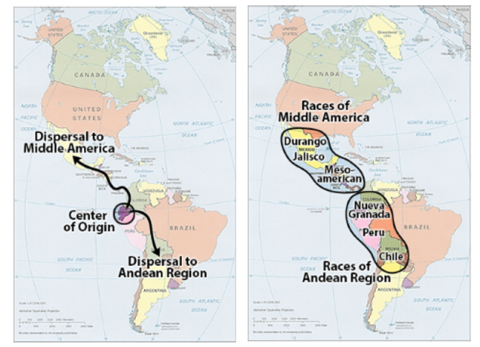
Bean Gene Pool
Genetic analysis using DNA marker diversity and Amplified Fragmented Length Polymorphism (AFLP) suggest that there are four wild bean gene pools, centered in: (1) Middle America (Mexico and Central America); (2) Colombia; (3) Western Ecuador and Northern Peru; and (4) the southern Andes (Tohme et al., 1996). The cultivated bean gene pool is derived mainly from the southern Andean wild bean gene pool and the Middle American gene pool. Wild stands are shown in Fig. 2.
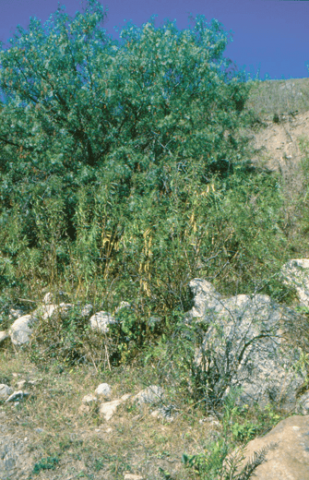
Different Races
The major gene pools in turn have been divided into different races based on plant morphology, adaptation range and agronomic traits (Fig. 3).
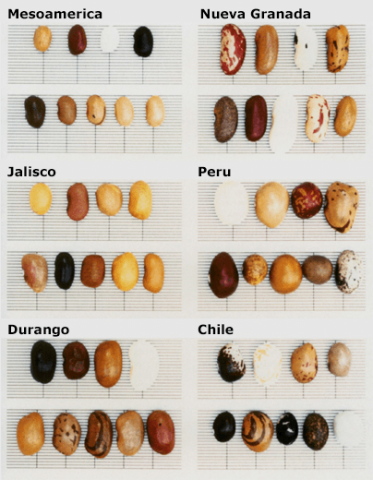
Biology of the Crop
General Characteristics of the Development of the Bean Plant
The biological cycle of the bean plant is divided into a vegetative phase and a reproductive phase following that. The vegetative phase starts from germination of the seed and ends when the first floral buds appear in cultivars of determinate growth habit, or the first racemes in cultivars of indeterminate habit. The reproductive phase ranges from the moment the first floral buds or racemes appear, to maturity. In plants of indeterminate growth habit, vegetative structures continue to appear when the vegetative phase has ended, which makes it possible for a plant to produce leaves, branches, stem, flowers and pods simultaneously. In determinate growth habit, the vegetative phase ends when the floral buds appear.
Growth stages of common bean are categorized into four groups (Schwartz et al., 2010).
Group 1: Emergence & Early Vegetative Growth
- VE: Emergence of hypocotyl from soil (crook stage)
- VC: two cotyledons & primary leaves at nodes 1 & 2
- V1: 1st trifoliolate leaf unfolded at node 3
- V2: 2nd trifoliolate leaf unfolded at node 4
- V3: 3rd trifoliolate leaf unfolded at node 5
Group 2: Branching & Rapid Vegetative Growth
- V4: 4th trifoliolate unfolded at node 6 + branching
- Vn: nth trifoliolate leaf unfolded at node (n+2)
Group 3: Flowering & Pod Formation
- R1: one open flower (early flower) on the plant
- R2: 50% open flowers (mid flower)
- R3: one pod at maximum length (early pod set)
- R4: 50% of pods at maximum length (mid pod set)
Group 4: Pod Fill & Maturation
- R5: one pod with fully developed seeds
- R6: 50% of pods with fully developed seeds (mid seed fill)
- R7: one pod at mature color (physiological maturity)
- RH: 80% of pods at mature color (harvest maturity)
Photosynthesis
Beans are classified in a C3 photosynthetic pathway. The maximum leaf photosynthetic rates at ambient carbon dioxide (CO2) concentrations is estimated from 12 mg CO2 dm2 h-1 to 35 mg CO2 dm2 h-1. Recent report showed relatively high photosynthetic rates in common beans, and this might be due to improved measurement techniques, but still lower photosynthetic rates than soybean (White and Juan, 1991).
Photoperiod and Temperature
Common bean, like most plants, flowers only in response to a certain amount of exposure to sunlight or photoperiod (termed the critical photoperiod), and are described as being photoperiod-sensitive, while others flower regardless of exposure time, and are described as photoperiod-insensitive or day neutral. Whereas day neutral genotypes occur, most common bean cultivars show a short day response for flowering (i.e. plants of such cultivars flower when the length of night exceeds their critical photoperiod). Genotypes of a high proportion of large seeded and highland germplasm are photoperiod-sensitive. The International Center for Tropical Agriculture (CIAT) reported that the photoperiod effects on common bean phenology increases with temperature. Higher temperatures cause a greater overall rate of growth and development. In general, both temperature and photoperiod have strong effects on growth and development of the bean plant. The inheritance of photoperiod-temperature response of flowering is controlled by few major genes.
General Classification System of Beans
Classification by Utilization or Mode of Consumption
Common beans may be grouped based on the stage of plant maturity when they are consumed:
- green or snap beans are horticultural beans grown for, and consumed as, fresh or processed pods
- green shell or fresh beans are grown for, and consumed as, fresh, full-sized seeds
- dry beans are grown for dried ripe seeds.
Classification by Seed Characteristics
Dry common beans are primarily characterized by the great diversity of seed types within the species: a rainbow array of colors and color patterns, varying degree of brilliance, and several seed shapes and sizes exist as shown in Fig. 4.
- Seed type (color, size, shape, and surface texture) is the character most commonly used to classify beans. Seed size of commercial cultivars may vary from 17 grams (navy beans) to 100 grams per 100 seeds (Faba beans).
- Seed shape varies from round to oblong to kidney-shaped with many combinations of color patterns. Surface texture may be shiny (brilliant), opaque, or intermediate.
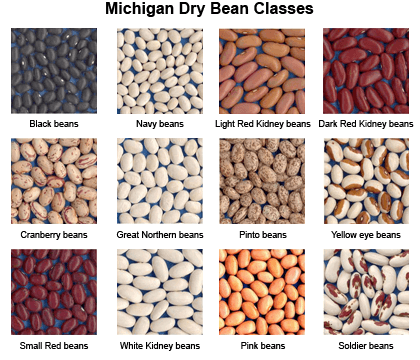
Classification By Growth Habit
Growth habit in beans varies from determinate dwarf beans to very vigorous indeterminate climbing beans. Common classification often divides beans into two or three groups: bush and climbing beans, or bush, semi-climbing, and climbing beans (Fig. 5).
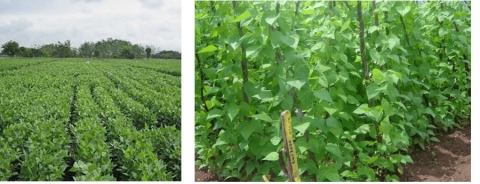
Classification by Duration of Growth Period
Bean varieties are usually grouped as early or late, however, the range of duration of growth-period varies from one region to another, or among varieties of different growth habits. According to growth habit and region, days to maturity among bean cultivars range from 60 to 300. The difference is not only varietal but also environmental, especially for the factors of day-length and temperature.
Adaption, Economic Importance, and Uses
Adaption
Common bean is a widely cultivated grain legume crop in tropical and subtropical areas of the world. Bean is adapted to a wide range of environments, and grows in latitudes between 52oN to 32oS in humid tropics, in the semi-arid tropics, and even in the cold climatic regions (Fig. 6).
It is a short-day tropical crop that requires between 300-600 mm precipitation to complete its life cycle, depending on soil, climate, and cultivar (Beebe et al., 2013).
Optimum crop production requires temperatures of between 21-24oC during the growing season and soil pH of between 6.3-6.7.
According to figures from FAO, world production is around 27.7 million tons (FAO, 2021). Latin America is the largest common bean-producing region, followed by the continent of Africa. Brazil, Mexico, and the USA are the three largest common bean-producing countries in the western hemisphere. In Africa, the majority of bean production is concentrated in the eastern and southern highlands extending from Ethiopia to South Africa. In this region, Kenya is the largest common bean-producing country. Common Bean production mainly occurs on dryland (i.e., depending on rainfall), with smaller land area under irrigated systems.
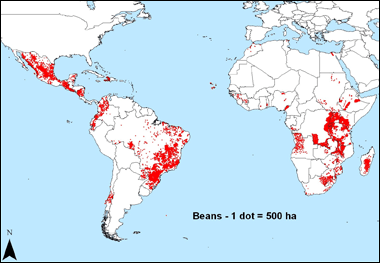
Common Bean in the Human Diet and Nutrition
Common bean is mainly grown for human consumption. In some countries it is one of the food security crops providing protein and fiber to more than 100 million people in Africa (Kimani et al. 2001). Common bean is mainly consumed as a mature grain in most parts of the world. Immature seeds, young pods and leaves are also consumed as a vegetable by some communities in sub-Saharan Africa and Latin America. Plant protein is the largest source of protein in human diet of poor people in the developing countries. Common bean therefore plays an important role in human diet due to its high protein content. Common beans are also a key source of minerals in human diet, especially iron.
Common Bean in Cropping Systems
In Africa, common beans are traditionally grown by farmers with small land holdings. This crop is often grown in complex farming systems as intercropped or in rotation with maize, sorghum, bananas, or other crops (Fig. 7).
The range of growth habits (from determinate bush types to vigorous climbers), and the range of growth cycles (from 3 to 10 months in length) allow common beans to fit many production niches.
In East and Central Africa, 23% of the production area is monocropped and 77% is grown in association, that is intercropping, with other crops (Katungi et al. 2010).
Monocropping is dominant in southern Africa with only 47% of the production area assigned to intercropping with other crops. In this cropping system, common bean has the capacity to break disease and pest cycles usually associated with cereals.
Atmospheric Nitrogen
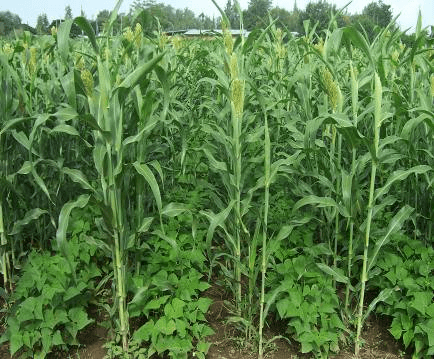
The ability to fix atmospheric nitrogen (N) for subsequent crops has made common bean a valuable crop in many smallholder cropping systems. Lunze and Ngongo (2011) reported that climbing beans have the capacity to fix 16-42 kg ha-1 of atmospheric N per season and this can be further increased with good agronomic and cultural practices, thus boosting yields of non-legume crops. For example, in East Africa, sorghum yield improvements of 40-57% were reported when sorghum was grown in rotation with climbing beans. In the eastern region of Central Africa, yield of cereal crops grown after climbing beans increased by 25-40%. In this region farmers have no capacity to purchase inorganic fertilizers, neither do they have enough animals to supply organic fertilizer in the form of manure. As a result, common bean acts as a source of N supply to primary cereal crops. Common bean is therefore important in improving the soil health and helps maintain soil fertility.
Production Constraints
Biotic Constraints
Biotic stresses such as diseases and pests are universal constraints to common bean production, especially fungal pathogens. Under favorable disease conditions, fungal pathogens cause significant yield losses. Yield losses also occur due to insect damage (Table 1).
Anthracnose, rust, and angular leaf spot are widely distributed, while rhizoctonia web blight and ascochyta blight can be locally intense in warm-moist environments, respectively. In recent years, root rots have emerged as a significant problem for common bean production, especially those caused by Pythium spp. and Fusarium spp. Insects are occasional problems. In Central America the bean pod weevil, Apion godmani and A. aurichalceum, is the most important pest, while in East Africa the bean stem maggot, aphids, and pod borers cause the most serious problems.
Abiotic Constraints
Abiotic stress is the major constraint to bean productivity in most tropical countries. Abiotic factor such as extreme limited water stress (drought) cause yield loss in Mexico, Brazil, Central America, and Eastern and Southern Africa. Heat stress adversely affects the cultivation of beans in Central and Southern America and Africa (Beebe et al. 2011). Nutrient deficiencies of phosphorous (P) and nitrogen (N) also reduces yield, while Aluminum and Manganese toxicity associated with acid soil, as well as low Calcium availability, cause significant common bean yield loss (Table 1).
| Limitation | Frequency | Intensity | Risk |
|---|---|---|---|
| Pests and diseases | +++ | +++ | ++++ |
| Drought | ++ | ++++ | |
| Low soil fertility | +++++ | +++ | + |
| High temperatures | +++++ | +++ | + |
| + : very low +++++ : very high Source: Adapted from Beebe et al. 2006b |
n/a | ||
International Breeding Centers
The International Center for Tropical Agriculture (CIAT) was established in Cali, Colombia, under the Consultative Group on International Agricultural Research (CGIAR) system (in 1971) with the mandate to work on common bean (Phaseolus vulgaris L.). CIAT coordinates all common bean research programs at the national level. Strong collaborative and active breeding programs are found in many countries throughout the tropics of the Americas and Africa, with interchanging of improved germplasm among countries.
The primary mission of CIAT’s bean program is to contribute to global food security. Their goal includes making bean production more profitable for small scale farmers in Africa, Latin America and the Caribbean countries.
CIAT has successfully developed bean varieties with genetic resistance to major diseases and pests, which have helped to minimize yield losses for farmers. More recently breeding programs have focused on breeding for improved bean tolerance to abiotic stresses such as drought and soil problems. These efforts have gained more significance due to more erratic climatic conditions that change the patterns and intensity of both abiotic and biotic stresses. CIAT’s breeding strategy for beans focusses on priority bean grain (market class) types.
Supporting Broad Goals
The CIAT’s bean program uses tools that allow them to support the broad goals including exploiting the biodiversity of more than 35,000 accessions in CIAT collection, biotechnology, particularly marker assisted selection, and gene discovery.
CIAT outlines the technical contributions and responsibilities for various regional bean breeding centers such as ECABREN (East and Central Africa Bean Research Network) and SABREN (South African Bean Research Network), and national bean breeding programs, universities and advanced research institutions.
Breeding Methods
Improving Seed Yield
Common bean is a self-pollinating crop, and thus breeding methods to improve seed yield and other important traits have followed methods similar to those applied to autogamous crops. These include pedigree selection (most commonly used breeding system in common bean improvement), back cross (for highly heritable traits, usually under single gene control), inbred back cross (1 or 2 back cross, followed by selfing), congruity back crossing (alternate crossing to each parent in alternate generations – maintains heterozygosity), recurrent selection (Fig. 8), single seed descent (among closely related elite lines), gamete selection (individual F1 plants of multiple parent crosses give rise to families) have been used. The breeding strategies of common bean have also followed approaches similar to those applied to other crops (Gepts, 2002). These approaches are described in Fig. 9. In addition, a three-tiered breeding strategy has been proposed to accommodate gene exchange between distantly related parents and to have more success for integrated genetic improvement of common bean (Fig. 10).
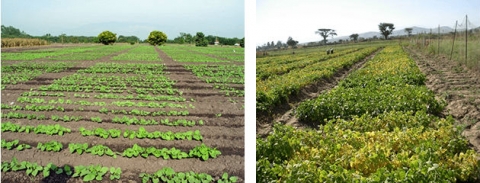
General Steps
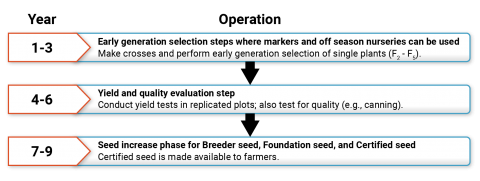
Breeding Pyramid
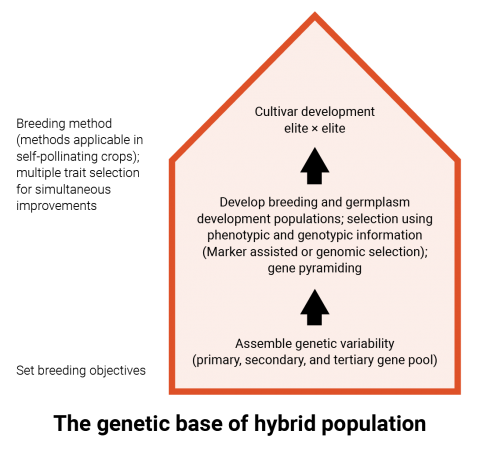
References
Beebe, S., I. Rao, H. Terán, and C. Cajiao. 2006b. Breeding concepts and approaches in food legumes: The example of common bean. p. 23-29. In: K. Ali, G. Kenneni, S. Ahmed, R.S. Malhotra, S. Beniwal, K. Makkouk, and M.H. Halila (eds.), Food and forage legumes of Ethiopia: Progress and prospects. Proceedings of the Workshop on Food and Forage Legume, 22-26 Sept. 2003. Addis Ababa, Ethiopia. EIAR and ICARDA, Allepo. Syria.
Beebe S., J. Ramirez, A. Jarvis, I. M. Rao, G. Mosquera, J. M. Bueno, and M. Blair. 2011. Genetic improvement of common beans and the challenges of climate change. In: Yadav SS, Redden RJ, Hatfield JL, LotzeCampen J and Hall AE (eds), Crop Adaptation to Climate Change. John Wiley and Sons, Ltd. Published by Blackwell Publishing Ltd., pp. 356-369.
Beebe. S., I. Rao, M. Blair, and A. Jorge. 2013. Phenotyping common beans for adaptation to drought. Front Physiol. 2013; 4: 35.
FAO. 2021. FAOSTAT: FAO Statistical Databases. Available online at: http://faostat.fao.org/
Gepts, P. 2002. A Comparison between Crop Domehttp://faostat.fao.org/stication, Clasical Plant Breeding, and Genetic Engineering. Crop Science 42(6) 1780-1790.
Katungi E., A. Farrow, T. Mutuoki, S. Gebeyehu, D. Karanja, F. Alamayehu, L. Sperling, S. Beebe, J.C. Rubyogo, and R. Buruchara. 2010. Improving Common Bean productivity. An Analysis of socio-economic factors in Ethiopia and Eastern Kenya. CIAT Working document #217.
Kelly, J.D. 2010. The Story of Bean Breeding. Michigan State University (Ed.). U.S.A. 30 pp.
Kimani, P.M., R. Buruchara, K. Ampofo, M. Pyndji, R. M. Chirwa, and R. Kirkby. 2001. Breeding beans for smallholder farmers in Eastern, Central, and Southern Africa: Constraints, achievements, and potential.
Lunze, L., and M. Ngongo. 2011. Potential nitrogen contribution of climbing bean to subsequent maize crop in rotation in South Kivu province of Democratic Republic of Congo. In A. Bationo, B. Waswa, J. Okeyo, F. Maina & J. Kihara, eds. Innovations as key to the Green Revolution in Africa, pp. 677681. Dordrecht, The Netherlands, Springer Science.
Singh S.P., P. Gepts, and D.G. Debouck. 1991. Races of common bean (Phaseolus vulgaris, Fabaceae). Econ. Bot. 45, 379396.
Schwartz, H.F., and M.A.C. Langham. Growth Stages of Common Bean. 2010. Legume ipmPIPE Diagnostic Pocket Series (2 page diagnostic cards, distributed nationally), http://legume.ipmpipe.org/cgi-bin/sbr/public.cgi.
Tohme J., D. O. González, S. Beebe, and M.C. Duque. 1996. AFLP analysis of gene pools of a wild bean core collection. Crop Sci. 36, 13751384.
White. J., and I. Juan. 1991. Physiology of yield potential and stress tolerance. Pages 287-382 in A. van Schoonhoven and O. Voysest, eds., Common beans: research for crop improvement. C.A.B. Int., Wallingford, UK and CIAT, Cali, Colombia.

